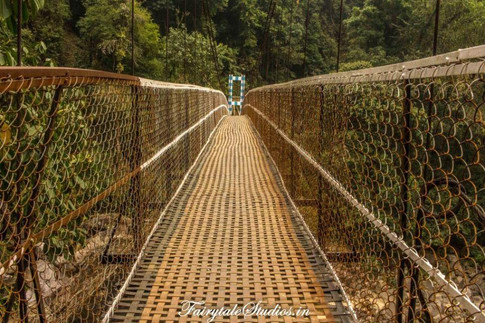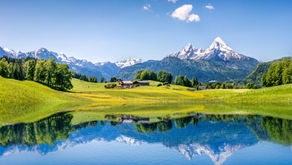Travel Guide to Sohra (also known as Cherrapunjee) - The Meghalaya Odyssey
- Fairytale Studios
- May 12, 2018
- 10 min read
Updated: May 29, 2022
Meghalaya, a North East Indian state, is surrounded by breathtaking mountains and ageless forests. This state has abundant places that are still unexplored and hence are hidden from the wrath of homosapiens. Cherrapunjee (also spelled Cherrapunji), is a town in Meghalaya which everyone can relate to from their childhood textbooks as being the wettest place on Earth. Though this title is no more held by Cherrapunjee (Mawsynram – another town in Meghalaya holds this position now), it still receives plenty of rainfall during monsoons. Supported by high plateaus and steep valleys, high rainfalls enable Cherrapunjee to have countless waterfalls of all forms and shapes. Mystical waterfalls, abundant caves and one of its kind double decker living root bridge makes Cherrapunjee a must visit for anyone traveling to Meghalaya.

In this fifth blog of the series – The Meghalaya Odyssey, we will present a detailed travel guide to Cherrapunjee along with recommendations around stay and itinerary. Note that historic name as well as now official name of this place is Sohra. We will be using the more popular name Cherrapunjee in this travel guide as well as series.
'The Meghalaya Odyssey' is a series of 10 travel blogs and 2 photo blogs. Check out other blogs in the series by clicking on the below mentioned links or photographs:
5. Sohra (Cherrapunjee) Travel guide - This article
How to reach Cherrapunjee
Guwahati railway station or airport are the nearest pit stops to Cherrapunjee. On reaching Guwahati the cheapest way to reach Cherrapunjee is to take a shared taxi till Shillong which takes around 3 hours and again a shared taxi all the way to Cherrapunjee which is little over an hour’s drive. Shillong too has a domestic airport but flights here are far less frequent and more costly. If you are on a long trip and do not have budget constraints, it is advisable to hire a car or self-drive from Guwahati for your entire journey including Cherrapunjee. The roads in most parts of Meghalaya are well maintained and driving on your own should not be a problem if you have driven on somewhat hilly areas before.

Best Time to visit Cherrapunjee
The weather conditions of the town remain pleasant and comfortable for the most of the year. But without a doubt, the best time to visit Cherrapunjee is during monsoon or months right after the monsoon. May-October remains the best time to witness the abundant waterfalls that Cherrapunjee has to offer. However, October-December are most preferred as it is less foggy and has sparse rainfall which will allow you to move around much more freely. January onwards most waterfalls start drying up as they are rainfall fed and this season is preferred by trekkers.

Here you can see the difference in one of the most famous waterfalls of Meghalaya - Nohsngithiang Falls or more popularly known as Seven sister falls. The picture in top taken during monsoon presents a very different view compared to picture on the right taken in february when there is absolutely no sign of even a single sister i.e. even a single stream of water. However during or after monsoon, it will be almost impossible to do many a treks that Meghalaya offers due to excessive slushiness.
Duration of stay in Cherrapunjee
Cherrapunjee can be covered in 2 nights and 3 days. However, it will be good to have 3 nights in hand to ensure you have enough time to absorb what Cherrapunjee has to offer. Also, a visit to Nongriat to see Double decker living root bridge will use up your one full day or even more in case you plan to stay overnight at Nongriat. Rest of the sightseeing spots in Cherrapunjee can be covered in a day or little more depending on your speed and interest. Depending on rains, your schedule might again be affected so having a day in hand at Cherrapunjee is always advisable.
Places to visit in Cherrapunjee
Caves in Cherrapunjee: Meghalaya is blessed with beautiful caves which were carved out of limestone deposits. It is globally recognized by the International Caving organizations with sub-continents’ longest and deepest caves, besides also having the longest sandstone cave. And they have not even completely explored many caves yet. Though most of these caves are in Jaintia region, below are a few astonishing caves you can visit in Cherrapunjee:
1. Mawsmai Caves

Mawsmai Caves are located at a distance of roughly 6 kilometres from the main town of Cherrapunjee. These caves are natural limestone formations. The caves are more than 800 feet long but only a small section of 150 meters is open for tourists. The caves are well lit from inside with halogen lamps. The entrance is wide but as one moves further inside, the opening becomes narrower and narrower. One has to duck and squeeze through a couple of areas in the caves. The entry and exit points are different; hence if you are unsure of squeezing so tightly, return back to the entrance. We would not recommend going to Mawsmai caves if you are too old or for small kids to venture alone. One needs to be cautious of bumping yourselves at most points. Caving inside Mawsmai caves is adventurous and unusually beautiful. The stalagmites and stalactites formations are amazing with varied colors and patterns. This natural creation is a work of abrasion and underground water since hundreds of years.
Note: Visiting time to Mawsmai Caves is from 9:30 AM to 5:30 PM. The entrance fee is INR 20 per adult and INR 20 for a camera.
2. Garden of Caves
Situated 10 kilometres from Cherrapunjee town, Garden of Caves is a natural space created by seasonal waterfalls. It is an amalgamation of caves, gardens, cascades and waterfalls surrounded by greenery. The caves and the gardens are centuries old and were used by the Khasi tribes to hide from the Britishers. The caves are open with a lot of sunlight. The major spots to view are the rock formations in the shape of – A King’s bed and Pillow, Heart-shaped rock, Baby rock, Cow-feet rock and Warrior rocks. The waterfalls can be viewed by descending several stairs down from the Garden of Caves. The area is clean and well-maintained. Walking sticks are available at the entrance for the elderly.
Note: The entrance fee to the garden is INR 20 per adult and INR 20 for a camera.

3. Arwah Caves
Arwah Caves are located on the way to Cherrapunjee from Shillong. In these particular caves, you will find local guides at the entrance to help you discover the caves. It is advisable to hire the guides as these caves are no less than a maze and you could easily be lost. The caves are not lit so well as the Mawsmai Caves. The water keeps dripping and various tiny streams are formed inside the caves. The rocks inside the caves have a yellowish glow and look slimy. You can also spot various fossils in the rock. The guide flashes his torch light on everything there is to see.
Note: Entrance fee to Arwah Caves is INR 20 per person and INR 50 for a camera.
Waterfalls in Cherrapunjee: As already briefed upon earlier, Cherrapunjee can be named land of waterfalls. In monsoon you would come across countless waterfalls in one sight. Some photographs taken around Cherrapunjee can be as mesmerizing as some of the waterfalls of Iceland.
1. Wah ka ba falls
The first spellbinding waterfall of Cherrapunjee is located just before you hit the town and is called as WahKaba Falls. The waterfalls is right in the middle of a deep canyon with beautiful views and the water falls right into the deep gorges of the canyon. One can easily get a 360 degree view of WahKaba waterfalls from the several different viewpoints here. At a height of 180 m, WahKaba falls provide an iconic view of the surrounding valley. The view point is a short 10-15 minute descend from the road and if you are old, you might find it difficult to climb back up.
The best part about this waterfall is that depending on amount of water, you can even go to the mouth of the falls and get a breathtaking view.
Note: The entrance fee to the waterfalls is INR 10 per person.
2. Nohkalikai Waterfalls

Nohkalikai Falls is a noteworthy waterfalls in Cherrapunjee. It falls from a height of 335 meters (1120 feet) as is regarded as the fifth highest waterfall of the world. It is the tallest plunge waterfall of India. The water falls in a single stream and bounces off the rocks below generating a lot of mist. The name ‘Noh-Ka-Likai’ refers to the ‘Jump of Ka Likai’. As per the legendary story, a lady named Likai jumped off the cliff, just like the Nohkalikai fall does, when she came to know that her husband killed her only child.
Setting aside the tragic story, Nohkalikai waterfalls is truly mesmerizing and thanks to the several viewpoints made, one can savour the panoramic vista of the falls from different angles. The waterfall cascades down into a gorge with green pool below. One can also trek to the base of the waterfall or uphill to the originating point of the waterfall.
Note: The entrance fee to the Nohkalikai waterfall is INR 10 per person.
3. Dainthlen Falls
Just before reaching Cherrapunjee town, a 5 kilometre drive off route leads one to Dainthlen Falls. The waterfall derives its name from a Thlen or a snake of gigantic size which dwelt in a cave. Legend has it that the people destroyed the snake in order to rid themselves of its reign of terror. Adjacent to the very spot where Thlen was slaughtered lies the Dainthlen Waterfalls. Natural rock carvings of the episode draw visitors to see the image of the Thlen, the symbol of greed, corruption and evil. With no trekking required, one can view this waterfall right from its bed. The breath-taking views of the waterfall are a treat to the eyes.
Note: The entrance fee to the Dainthlen waterfall is INR 10 per person.
4. Nohsngithiang Falls or Seven Sister Falls
Also known as Seven Sisters’ Waterfall or Mawsmai Falls, the Nohsngithiang Falls derives its name from the fact that seven streams flow down the cliff. The waterfall is situated south westerly and gets illuminated by sun from dawn to dusk giving it vibrant colors and thus making it a sight to behold. The water falls from a height of about 1106 feet, thus making it fourth highest waterfall in India. The falls are created by water of River Kynshi. The seven streams of waterfall flow together over the hill in parallel formation with the gushing misty breeze blows on to your face moistening you. Monsoon is the best time to see all the seven falls side by side.
Living Root Bridge
Deep in Meghalaya’s forests, grow the famous ‘living root bridges’. Artistically crafted by the local tribes, the bridges are made from the living roots of rubber tree planted on each side of the fast flowing streams. Traditionally, the roots are guided by the tribal people and tied for increased support. Read a brief about our visit to the living root bridge below:
Umshiang Double Decker living root bridge:
The Umshiang double decker living Root Bridge is the mecca of all the living root bridges in Meghalaya. Getting there is no simple task. One has to descend 3500 cemented steps to Nongriat village that houses the Double decker living Root Bridge. The trek starts from a village named Tyrna which is located about 30 kilometres from the main town of Cherrapunjee. Descend through the steps surrounded by dense forests is however easy than ascend.

After descend of 1000 steps and trekking slightly off-route is a single decker living Root Bridge named Ritymmen, which hangs over a rain-fed river. Being 50 metres long, Ritymmen is also the longest known living root bridge. The bridge shakes and swings as one walks over it making the experience more adventurous. Despite double decker living root bridge being the main attraction in this region, we would strongly recommend you to see Ritymmen living root bridge at Nongthymmai village on the way or while returning from Nongriat.

Some more memorable hike towards the double decker bridge passes through several small villages always smiling and welcoming. There are also couple of beautiful footbridges on the way. Hanging over the water, the two bridges are created from the huge rubber trees sitting on either side. The roots are intertangled in a complex manner making the bridges more sturdy and strong. It’s truly a wonder in itself. The stream of water below is a perfect spot for a ‘Fish Spa’ and just dipping your feet in the cold waters feels so relaxing after a long trek. The landscape seems like it has been pulled straight from the pages of a fairytale.
Trekking ahead the Double decker living Root Bridge takes one to the natural pools and the famous Rainbow falls. We recommend going this way based on your physical limitations. The journey back to top is pretty treacherous and you should keep this in mind. If you are old or have health issues, we would suggest do not attempt visiting the double decker living root bridge. Instead, go to Riwai, a village near Mawlynnong which has a lovely living root bridge (though not double decker) which requires barely 15 minutes of walk one way.
Note: The entrance fee to the living root bridge is INR 20 per person and INR 20 for a camera. There is a separate charge for GoPro (Rs.100) and video camera (Rs.200). Buying walking sticks from the starting Tyrna village will help your knees to a great deal. You can also opt for staying at the Nongriat village in homestays for a night and ascend back the next day.
Apart from these above mentioned places to visit, Thangkarang Park is popular among kids though adults might not find it interesting. Mawkdok Dympep Valley view point, located at the start of the Cherrapunjee town is a prominent attraction which provides an enticing view of the Sohra valley. There is also a zip lining above the valley by Pioneer Adventures which can be a very adventurous experience. And there are some more seasonal waterfalls like Kyrem Falls and a museum - Ram Krishna Mission & Museum, which you can visit in case you have more time.

Accommodation in Cherrapunjee
Cherrapunjee has many options to stay of varying budgets and types. However, as you might know, we always look for offbeat accommodations which are an experience in itself. At Cherrapunjee, we found Sa-I-Mika resort which gives you an experience of staying close to nature in rustic Khasi styled cottages giving amazing views while providing all the amenities you would want. The whole setup is minimalistic and rooted, yet comfortable and experiential. Sa - I - Mika resort is located centrally to most sightseeing spots and yet away from any hustle of the Sohra town. You can read a detailed account of our experience at Sa-I-Mika resort.
As you would have realized Cherrapunjee or Sohra is a must visit destination in Meghalaya. It provides such as breadth of experiences from spellbinding waterfalls to awe inspiring living root bridges. Walking down the villages around Nongriat which seem so far away from the modern world yet so advanced in their own unique ways is truly worth pondering. Visiting Cherrapunjee in different seasons can be all together a different experience as well. One can also gaze upon flats of Bangladesh from some points in Cherrapunjee and see the streets light up in all together a different country.
PIN THIS IMAGE
Hope this in depth guide to Cherrapunjee would help you chart a detailed itinerary and make your bookings for stay. Do you feel we have missed out any specific detail? Would you like us to add any other detail? Do let us know your thoughts in comment section below. You can read our next travel guide to Mawlynnong and photoblog on life in Mawlynnong.







































































Comments